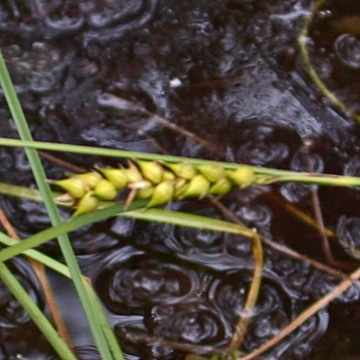

Carex striata - (image 1 of 2)
Taxonomy
Family: Cyperaceae
Section Paludosae
Synonymous with C. walteriana
Habitat
Acidic, sandy or peaty swamps, sedge meadows, bogs.
Associates
Distribution
Mainly along the coast from southeast MA to FL, MS, and AL.
Morphology
Colonial by long creeping rhizomes, strongly aphyllopodic; stems 40-120 cm; main leaves 2-5 mm wide; staminate spikes 1 or 2, the terminal one 3-5 cm; pistillate spikes 1 or 2, crowded, cylindric, erect, 2-4 cm, sessile or nearly so; lowest bract elongate, surpassing the stem; pistillate scales ovate, half to nearly as long as the perigynia, with red-purple side and hyaline margins, acute to acuminate; perigynia coriaceous, ovoid, (4-)4.5-6.5 mm, with numerous impressed nerves, acuminately tapering to a bidentate beak a fourth as long as the body; achene concavely trigonous.
Notes
Fruiting April to July
Wetland indicator: OBL
From NJ southward plants tend to have increasingly pubescent perigynia. Northern plants with glabrous perigynia are sometimes treated as var. brevis.
References
Ball, P.W. and A.A. Reznicek. 2002. Carex, In: Flora of North America Editorial Committee, Eds. Flora of North America North of Mexico. Volume 23. Oxford University Press, New York.
Gleason, Henry A. and A. Cronquist. 1991. Manual of Vascular Plants of
Northeastern United States and Adjacent Canada. Second Ed.
The New York Botanical Garden. Bronx, NY
|
© Michael Hough 2018 |